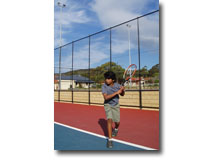Coaching Tip - October 2017
Body Language
A measure of your oncourt vibes
All Tennis players give off a vibe – body language – which will probably alternate between postive and negative during a Club/ tournament match and maybe even during training sessions.
Your body language (vibe) on court will have a huge impact not only on your own tennis game but on your opponent(s) performance as well.
What is Body Language?
A player’s Body Language (vibe) is displayed as a result of every thing you do (your actions) on the Tennis court between points and during the rallies i.e.
• The way you walk
• Stand
• Talk
• React to points
• React after points
Every one of your actions will send a signal or signals to your opponent which they should pick up on either consciously or subconcoiusly
Similarly you should be able to pick up the Body Language signals (vibes) in the same way from your opponent.
These signals (vibes) can be positive when the player is
• confident
• strong with their tennis strokes
• strong mentally
or negative when the player is
• nervous
• irritated
• tired physically and mentally
• frustrated
As a rule Body Language never lies.
How Body Language affects your opponent or YOU
Negative signs
When a player is behind and under pressure in a match they can start to
• feel frustrated
• droop the head and shoulders
• move slowly between points
• yell out abuse in anger
• smash tennis racquets
• hit Tennis balls in anger into the crowd or onto other courts
This display of negativity will not only encourage the opponent and makes them feel more in control so that they will be able to lift their game to a higher level but make it harder for the negative player to make a comeback.
Positive signs
A positive Body language as follows will send out danger signals to your opponent(s) by
• Pumping your fist after hitting great shots or winners
• Moving quickly between points and the change of ends
• Keeping your head and shoulders up
• Giving the impression that you have plenty of energy
Maybe jog up and down on the spot and/or to the chair or to change ends so that you can be quickly ready to play the next point or game.
Don’t show that you are breathing heavily after a long rally or even hold your breath when you walk past your opponent(s) at the change of ends.
Players should try to use positive body language to introduce and maintain a positive mindset during their Tennis matches.
This will help to introduce a positive circle of influence i.e.
the body influences the mind
and the mind influences the body
which when established will help you to take your tennis game to a higher level particularly in the tighter matches.
The key is to, while keeping your body language on track, check your opponent’s body language for signs of frustration and tiredness or other negative vibes.
Body language involving the use of the positive aspects and restricting the negatives is a large part of coping with the Mental battle faced oncourt during a competitive tennis match.
So much so that Tennis players competing at the higher levels have often sought assistance from Sports Physcologists to help them to adjust to and deal with the Mind games involved during Tennis matches and tournament play.
I hope that you have found this article on Body language and using it to your adavantage of interest and that it will help you to take your game to the next level.
Contact me if you have comments or queries.
Do you have any Body language stories to tell.
Tennis the game of a lifetime
Enjoy your Tennis experience
Coach Steve
Email steve.james@stevejamestennis.com
Website www.stevejamestennis.com







